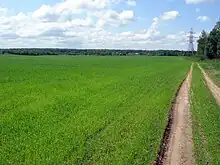The Food Security Doctrine (Russian: Доктрины продовольственной безопасности Российской Федерации) is an agricultural policy of the Russian Federation adopted first in 2010, and revised latest in 2020.[1]
History
The first draft of a comprehensive national food security policy was created by the Russian Ministry of Agriculture in the 1990s, which however met strong resistance from other economic ministries and was vetoed by then president Boris Yeltsin due to budgetary limitations.[2] In 2006, Russia adopted the Federal Law on the Development of Agriculture (Russian: ФЕДЕРАЛЬНЫЙ ЗАКОН 29 декабря 2006 г. N 264-ФЗ "О развитии сельского хозяйства") which was the first legal document that provided basis for supporting agricultural production.[3]
2010 first version
On January 21, 2010, then Russian president Dmitry Medvedev signed Russia's first Food Security Doctrine, which is a non-legislative framework document that outlines the agricultural production goals in order to achieve domestic food self-sufficiency.[4][5] The doctrine is referred to by the National Security Strategy of the Russian Federation to 2020.[6]

The doctrine also justifies governmental actions in response to foreign dumping or export subsidy that are deemed as detrimental to the Russian market.[4] The doctrine has also established the following domestic production goals as the share of domestic production in the total food supplies:[7]
- grain - 95 percent
- sugar - 80 percent
- vegetable oil – 80 percent
- meat and meat products (on meat basis) – 85 percent
- milk and dairy products (on milk basis) – 90 percent
- fish product - 80 percent
However, there is no specific instructions on the timeframe, enforcer or funding for meeting the targets.[4] According to USDA, the doctrine fails to specify any concrete measures to reach the targets which severely limits its effectiveness.[7]
In 2019, then Russian Prime Minister Medvedev stated that most of the goals outlined by the doctrine had been met in the past decade.[8]
2020 revised version
On January 21, 2020, Russian President Vladimir Putin signed a revised version of Food Security Doctrine for Russia.[9] According to the Russian Ministry of Agriculture, the emergence of new economic conditions such as economic sanctions, Russia's accession to the WTO and enhanced integration processes within the Eurasian Economic Union prompted the revision of the doctrine.[10]
The revised version of the doctrine focused on preventing the import and use of genetically modified organisms for planting or genetically modified animal for being raised.[11] A revised set of production goals were also published as following:
| Product | Self-sufficiency target set in 2010 | New Self-sufficiency target set in 2020 | Actual production level in 2019 |
|---|---|---|---|
| Grain | 95 percent | 95 percent | 170.5 percent |
| Sugar | 80 percent | 90 percent | 112.6 percent |
| vegetable oil | 80 percent | 90 percent | 198.4 percent |
| Meat and Meat Products (on meat basis) | 85 percent | 95 percent | 94.6 percent |
| Milk and Dairy Product (on milk basis) | 90 percent | 90 percent | 81.7 percent |
| Fish Products (in live weight – raw weight) | 80 percent | 85 percent | 154.5 percent |
| Potatoes | 95 percent | 95 percent | 100 percent |
| Vegetables, Melons and Gourds | NA | 90 percent | 95.8 percent |
| Fruit and Berries | NA | 60 percent | 33.9 percent |
| Seeds of Key Ag Crops of Domestic Selection | NA | 75 percent | 2-90 percent |
| Edible salt | 85 percent | 85 percent | 63.6 percent |
See also
References
- ↑ Dronin, Nikolai M.; Sveshnikov, Stephan (2021). "The Russian Food Security Doctrine: Historical Roots and Major Limitations". Exploring and Optimizing Agricultural Landscapes. Springer International Publishing: 131–159. doi:10.1007/978-3-030-67448-9_4. Retrieved 6 December 2023.
- ↑ "The Legacy of Boris Yeltsin". rusi.orghttps. 25 April 2007. Retrieved 7 December 2023.
- ↑ "Federal Law No. 260-FZ "On state support in the field of agricultural insurance" and on amendments to the Federal Law "On agricultural development"" (PDF). Food and Agriculture Organization of the United Nations. Retrieved 7 December 2023.
- 1 2 3 "Утверждена Доктрина продовольственной безопасности Российской Федерации". Президент России (in Russian). 1 February 2010. Retrieved 6 December 2023.
- ↑ "Russia: The Eurasian Center for Food Security is Launched". World Bank. Retrieved 6 December 2023.
- ↑ "National Security Strategy of the Russian Federation to 2020" (PDF). MepoForum.sk. Retrieved 6 December 2023.
- 1 2 Vassilieva, Yelena; Smith, Mary Ellen. "Russian Federation Food Security Doctrine Adopted" (PDF). USDA Foreign Agricultural Service. Retrieved 6 December 2023.
- ↑ Azarieva, Janetta; Brudny, Yitzhak M.; Finkel, Eugene (18 October 2023). "Food, Security, and Food Security". Bread and Autocracy: 85–100. doi:10.1093/oso/9780197684368.003.0006. Retrieved 7 December 2023.
- ↑ "Russia's Food Security Doctrine approved". en.kremlin.ru. President of Russia. 21 January 2020. Retrieved 6 December 2023.
- ↑ Götz, Linde; Heigermoser, Maximilian; Jamali, Jaghdani. "Russia's food security and impact on agri-food trade" (PDF). EconStor. Retrieved 6 December 2023.
- ↑ "Russia: New Food Security Doctrine Adopted | USDA Foreign Agricultural Service". fas.usda.gov. 7 February 2020. Retrieved 7 December 2023.